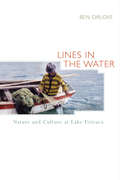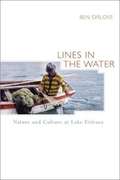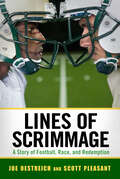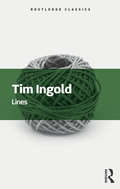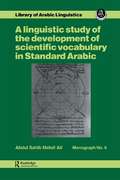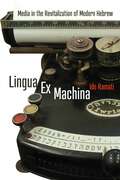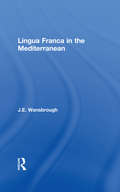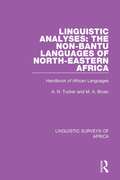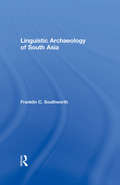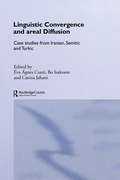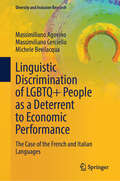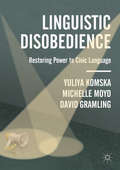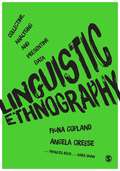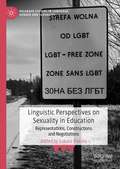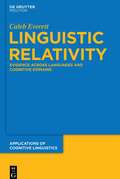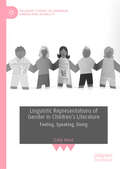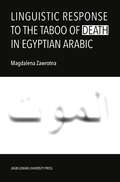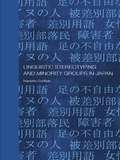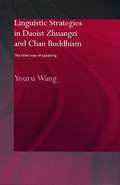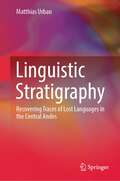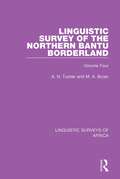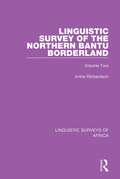- Table View
- List View
Lines in the Water: Nature and Culture at Lake Titicaca
by Ben OrloveThis beautifully written book weaves reflections on anthropological fieldwork together with evocative meditations on a spectacular landscape as it takes us to the remote indigenous villages on the shore of Lake Titicaca, high in the Peruvian Andes. Ben Orlove brings alive the fishermen, reed cutters, boat builders, and families of this isolated region, and describes the role that Lake Titicaca has played in their culture. He describes the landscapes and rhythms of life in the Andean highlands as he considers the intrusions of modern technology and economic demands in the region. Lines in the Water tells a local version of events that are taking place around the world, but with an unusual outcome: people here have found ways to maintain their cultural autonomy and to protect their fragile mountain environment. The Peruvian highlanders have confronted the pressures of modern culture with remarkable vitality. They use improved boats and gear and sell fish to new markets but have fiercely opposed efforts to strip them of their indigenous traditions. They have retained their customary practice of limiting the amount of fishing and have continued to pass cultural knowledge from one generation to the next--practices that have prevented the ecological crises that have followed commercialization of small-scale fisheries around the world. This book--at once a memoir and an ethnography--is a personal and compelling account of a research experience as well as an elegantly written treatise on themes of global importance. Above all, Orlove reminds us that human relations with the environment, though constantly changing, can be sustainable.
Lines in the Water: Nature and Culture at Lake Titicaca
by Benjamin S. OrlovePart ethnography, part natural history, part memoir, Ben Orlove's book reflects on the changes that have taken place over 30 years in the fishing villages along the shores of Lake Titicaca.
Lines of Descent
by Kwame Anthony AppiahW. E. B. Du Bois never felt so at home as when he was a student at the University of Berlin. But Du Bois was also American to his core, scarred but not crippled by the racial humiliations of his homeland. In Lines of Descent," Kwame Anthony Appiah traces the twin lineages of Du Bois' American experience and German apprenticeship, showing how they shaped the great African-American scholar's ideas of race and social identity. At Harvard, Du Bois studied with such luminaries as William James and George Santayana, scholars whose contributions were largely intellectual. But arriving in Berlin in 1892, Du Bois came under the tutelage of academics who were also public men. The economist Adolf Wagner had been an advisor to Otto von Bismarck. Heinrich von Treitschke, the historian, served in the Reichstag, and the economist Gustav von Schmoller was a member of the Prussian state council. These scholars united the rigorous study of history with political activism and represented a model of real-world engagement that would strongly influence Du Bois in the years to come. With its romantic notions of human brotherhood and self-realization, German culture held a potent allure for Du Bois. Germany, he said, was the first place white people had treated him as an equal. But the prevalence of anti-Semitism allowed Du Bois no illusions that the Kaiserreich" was free of racism. His challenge, says Appiah, was to take the best of German intellectual life without its parochialism--to steal the fire without getting burned.
Lines of Scrimmage: A Story of Football, Race, and Redemption
by Joe Oestreich Scott PleasantAs in many small towns in the South, folks in Conway, South Carolina, fill the stands on fall Fridays to cheer on their local high school football squad. In 1989--with returning starter Carlos Hunt at quarterback and having finished with an 8-4 record in 1988--hopes were high that the beloved Tigers would win their first state championship. But during spring practice, Coach Chuck Jordan (who is white) benched Hunt (who is black) in favor of Mickey Wilson, an inexperienced white player. Seeing this demotion of the black quarterback as an example of the racism prevalent in football generally and in Conway specifically, thirty-one of the team's thirty-seven black players--under the guidance of H. H. Singleton, pastor of Cherry Hill Missionary Baptist Church and president of the local NAACP--boycotted the team in protest.The season-long strike severed the town along racial lines, as it became clear that the incident was about much more than football. It was about the legacy of slavery and segregation and Jim Crow and other points of tension and oppression that many people in Conway--and the South--had wrongly assumed were settled.While the 1989 season is long over, the story reverberates today. Chuck Jordan is still coaching at Conway High, and he's still without that state championship. Meanwhile, Mickey Wilson is now coaching Conway's fiercest rival, the Myrtle Beach Seahawks. In the annual Victory Bell Game between Conway and Myrtle Beach, the biggest contest of the year for both teams, a veteran coach and his young protégé compete against each other--against the backdrop of a racial conflict that bitterly divided a small southern town.
Lines: A Brief History (Routledge Classics)
by Tim IngoldWhat do walking, weaving, observing, storytelling, singing, drawing and writing have in common? The answer is that they all proceed along lines. In this extraordinary book Tim Ingold imagines a world in which everyone and everything consists of interwoven or interconnected lines and lays the foundations for a completely new discipline: the anthropological archaeology of the line. Ingold’s argument leads us through the music of Ancient Greece and contemporary Japan, Siberian labyrinths and Roman roads, Chinese calligraphy and the printed alphabet, weaving a path between antiquity and the present. Drawing on a multitude of disciplines including archaeology, classical studies, art history, linguistics, psychology, musicology, philosophy and many others, and including more than seventy illustrations, this book takes us on an exhilarating intellectual journey that will change the way we look at the world and how we go about in it. This Routledge Classics edition includes a new preface by the author.
Ling Stu Of Dev Scient Vocab Ara
by AliFirst published in 1987. Routledge is an imprint of Taylor & Francis, an informa company.
Lingua Ex Machina: Media in the Revitalization of Modern Hebrew (Jewish Culture and Contexts)
by Ido RamatiAn investigation of the connections between the parallel rise of modern Hebrew and modern mediaAfter lying dormant for two millennia as a mainly written language, Hebrew awoke from its literary slumber to become a living modern vernacular. This revitalization is unique and unprecedented in world history, and its success has been studied in fields from linguistics to cultural history. However, the role of modern technologies in mediating this revival has not yet been considered.What happens when an ancient language meets modern technology? Lingua Ex Machina explores such a moment in its investigation of the role media technologies—including typewriters, phonographs, and computers—played in the revitalization and modernization of Hebrew from the end of the nineteenth century into the present day.Ido Ramati examines the role sound recording technologies played in shaping the reemergence of modern Hebrew speech, reveals how the Hebraized typewriter pushed for the modernization of writing in Hebrew, and ultimately argues that these media—whose development and adoption paralleled the revitalization of Hebrew—were an active force in shaping the language as a modern communicative medium. This case study of Hebrew furnishes researchers with a rare opportunity to investigate the complex relation between language, its speakers, and technology at a decisive moment, and sheds new light on the study of media technologies and their theoretical, lingual, and social implications.
Lingua Franca in the Mediterranean
by J. E. WansboroughThe subject of this study is the language of commerce and diplomacy during the period from 1500 BCE to 1500 CE. Based on texts of chancery provenance, its aim is the identification of a linguistic sub-system that effected and informed the major channel of international relations. The standard procedures of contact and exchange generated a format that facilitated inter-lingual transfer of concepts and terms. Lingua Franca refers to the several natural languages that served as vehicle in the transfer, but also to the format itself.
Linguistic Analyses: Handbook of African Languages (Linguistic Surveys of Africa #18)
by M. A. Bryan A. N. TuckerThis book, originally published in 1966, deals mainly with morphemes and with grammatical and syntactic behaviour. Although some vocabulary material is contained in this volume, and some more in the Linguistic Survey of the Northern Bantu Borderland, vocabulary comparison itself plays little part. The volume presents an overall picture of the working of representative languages from each section of the Handbook and provides grammatical material which will help future students in classifying the languages to their typological as apart from their lexical features.
Linguistic Archaeology of South Asia
by Franklin SouthworthThis book brings together linguistic and archaeological evidence of South Asian prehistory. The author depicts and analyses the region, in particular the Indus Valley civilization, its links with neighbouring regions and its implications for social history. Each type of linguistic data is put into its socio-historical context. Consequently, the book is both a description of the unique methodology 'linguistic archaeology' and a treatment of South Asian linguistic data.
Linguistic Convergence and Areal Diffusion: Case Studies from Iranian, Semitic and Turkic
by Éva Ágnes Csató Bo Isaksson Carina JahaniThe authors are outstanding scholars engaged in the study of language varieties spoken in 'convergence areas' in which speakers are multilingual in languages of at least two but sometimes all three language families. Many of the contributions present new data collected in fieldwork. The geographic area covered is Western and Central Asia where varieties of Iranian, Semitic and Turkic languages have entered into many different types of contact. The intricate linguistic contact situations demonstrate highly interesting convergence phenomena.
Linguistic Discrimination of LGBTQ+ People as a Deterrent to Economic Performance: The Case of the French and Italian Languages (Diversity and Inclusion Research)
by Massimiliano Agovino Massimiliano Cerciello Michele BevilacquaThis book explores the adverse economic effects of discriminatory language against LGBTQ+ people. The case studies under investigation are represented by the French and the Italian language, both boasting vast arrays of slurs employed to denote negatively the members of the LGBTQ+ community. Looking at the relative frequencies of slurs over time, the analysis proposed measures the extent of linguistic discrimination. Subsequently, the book identifies the negative impact of discrimination on economic performance in France and Italy in the long run. Slurs impose a psychological cost on the members of the LGBTQ+ community, who become as a result less productive in the workplace. Ultimately, slurs affect overall economic performance and reduce economic growth at the national level. This book stresses the role of inefficiencies associated with discrimination against LGBTQ+ individuals in various spheres of life, with a particular focus on their economic consequences. Discriminatory language thus emerges not only as a negative phenomenon per se, but also as an obstacle to economic growth. This work draws elements from different disciplines and the results it obtains may prove appealing to scholars of economics, linguistics and gender studies, as well as to policymakers seeking to overcome social exclusion while stimulating economic performance.
Linguistic Disobedience: Restoring Power to Civic Language
by Yuliya Komska Michelle Moyd David GramlingThis book asks how we—as citizens, immigrants, activists, teachers—can counter the abuse of language in our midst. How can we take back the power of language from those who flaunt that power to silence or erase us and our fellows? In search of answers, Linguistic Disobedience recalls ages and situations that made critiquing, correcting, and caring for language essential for survival. From turn-of-the-twentieth-century Central Europe to the miseries of the Third Reich, from the Movement for Black Lives to the ongoing effort to decolonize African languages, the study and practice of linguistic disobedience have been crucial. But what are we to do today, when reactionary supremacists and authoritarians are screen-testing their own forms of so-called disobedience to quash oppositional social justice movements and their languages? Blending lyric essay with cultural criticism, historical analysis, and applied linguistics, Linguistic Disobedience offers suggestions for a hopeful pathway forward in violent times.
Linguistic Ethnography: Collecting, Analysing and Presenting Data (Palgrave Advances In Language And Linguistics Ser.)
by Fiona Copland Angela CreeseThis is an engaging interdisciplinary guide to the unique role of language within ethnography. The book provides a philosophical overview of the field alongside practical support for designing and developing your own ethnographic research. It demonstrates how to build and develop arguments and engages with practical issues such as ethics, transcription and impact. There are chapter-long case studies based on real research that will explain key themes and help you create and analyse your own linguistic data. Drawing on the authors’ experience they outline the practical, epistemological and theoretical decisions that researchers must take when planning and carrying out their studies. Other key features include: A clear introduction to discourse analytic traditions Tips on how to produce effective field notes Guidance on how to manage interview and conversational data Advice on writing linguistic ethnographies for different audiences Annotated suggestions for further reading Full glossary This book is a master class in understanding linguistic ethnography, it will of interest to anyone conducting field research across the social sciences.
Linguistic Ethnography: Collecting, Analysing and Presenting Data (Palgrave Advances In Language And Linguistics Ser.)
by Fiona Copland Angela CreeseThis is an engaging interdisciplinary guide to the unique role of language within ethnography. The book provides a philosophical overview of the field alongside practical support for designing and developing your own ethnographic research. It demonstrates how to build and develop arguments and engages with practical issues such as ethics, transcription and impact. There are chapter-long case studies based on real research that will explain key themes and help you create and analyse your own linguistic data. Drawing on the authors’ experience they outline the practical, epistemological and theoretical decisions that researchers must take when planning and carrying out their studies. Other key features include: A clear introduction to discourse analytic traditions Tips on how to produce effective field notes Guidance on how to manage interview and conversational data Advice on writing linguistic ethnographies for different audiences Annotated suggestions for further reading Full glossary This book is a master class in understanding linguistic ethnography, it will of interest to anyone conducting field research across the social sciences.
Linguistic Perspectives on Sexuality in Education: Representations, Constructions and Negotiations (Palgrave Studies in Language, Gender and Sexuality)
by Łukasz PakułaThis book brings together leading academics and practitioners working in the area of language, gender, sexuality and education, consolidating recent developments and moving the field forward in a contemporary context. This unique and timely volume captures current themes, debates, theories and methods in the field, and will be of interest to scholars and practitioners working around the world in the areas of Applied Linguistics, Teaching English as a Foreign Language, Education, Sociology and Discourse Studies.
Linguistic Relativity: Evidence Across Languages and Cognitive Domains (Applications of Cognitive Linguistics Ser. #25)
by Caleb EverettThis book introduces the reader to the current findings on linguistic relativity, and in so doing helps to answer one of the most vexing questions in the cognitive and social sciences: Does the language you speak affect how you think?
Linguistic Representations of Gender in Children's Literature: Feeling, Speaking, Doing (Palgrave Studies in Language, Gender and Sexuality)
by Sally HuntThis book examines how aspects of gender and identity are represented in some of the best-selling children's book series published in English over the last 100 years. Combining the quantitative methods of corpus linguistics with Critical Discourse Analytic interpretation, the author's analysis shows how gendered constructions of identity are built on uneven patterns of representation. Stories, and the characters who inhabit them, not only provide child readers with entertainment, but also the building blocks of their identities: linguistic choices construct representations of how to be a girl or how to be a boy, often in binary, mutually exclusive terms. Hunt's critical corpus linguistic approach uncovers patterns of representation beyond the fiction author's awareness, which reveal their assumptions about how girls and women behave, or should behave, or what boys and men do, or should do. Chapters cover the gendered patterns found in how characters speak, how they express emotion and how they act on the world, as well as those characters who contradict these patterns and perform their genders in different ways. The detailed analysis and its implications will be relevant to teachers of literature, both at school and at university level, media researchers, lecturers and students of linguistics or gender studies, and anyone interested in child development and the fiction written for children.
Linguistic Response to the Taboo of Death in Egyptian Arabic
by Magdalena ZawrotnaThe work presents a study of the linguistic and pragmatic response to the taboo of death in Egypt. The analysis leads the author to the conclusion that the experience of death in Egyptian society is mediated by religion. The reaction to death announcements includes a number of strategies to protect both the author of the utterance and its recipient against the effects of the taboo related to this topic. The most important feature of the studied communication is formulaicity, which is at the same time the central idea and the methodological frame of the work presented here.The discourse analyzed here fits within the Arab-Muslim rhetorical framework. In the daily utterances of the Egyptians, divine agency is believed to be constantly present, which is attested in numerous ritual practices. As part of the quantitative study and the structural analysis of the material, a pattern was distinguished in which individual types of formulas occur in their fixed places and a specific order. Qualitatively, many of the statements in the material are strongly emotional. To enhance the pragmatic effect, phrases are combined with each other, repetitions, prayers, poetic attempts and quotes from the Quran/ Hadith appear. Most of the phrases used in response to the taboo of death are prefabricated items recalled from memory almost automatically. Further analysis proposes to look at the formulae in the context of taboo and strong emotions related to it. Using formulaic sequence instead of generating novel language enables. the author of the utterance to convey emotional support to the suffering person and, at the same time, eliminates ambiguity. The methodology proposed here offers a new insight into the language of everyday communication, through the lens of its pragmatic usefulness and linguistic etiquette, taking into account the cultural framework in which the analyzed utterances are performed.
Linguistic Stereotyping and Minority Groups in Japan (Routledge Contemporary Japan Series)
by Nanette GottliebThis book is the first full-length study in English to examine the use of discriminatory language in Japan. As in other countries, there has been much debate about the public use of language deemed demeaning to certain groups within society especially in relation to the issue of minority rights versus freedom of speech. Adding a new dimension to the discussion of language and society in Japan, the book focuses on an aspect of language and power which highlights some of the dissent underlying Japan’s officially promoted ideology of a harmonious society. The text presents a revealing examination of the discriminatory language, known as sabetsu yogo, as identified by five minority groups, the Burakumin, the Ainu, people with physical or mental disabilities, women and ethnic groups within Japan
Linguistic Strategies in Daoist Zhuangzi and Chan Buddhism: The Other Way of Speaking
by Youru WangAs the first systematic attempt to probe the linguistic strategies of Daoist Zhuangzi and Chan Buddhism, this book investigates three areas: deconstructive strategy, liminology of language, and indirect communication. It bases these investigations on the critical examination of original texts, placing them strictly within soteriological contexts. Whilst focusing on language use, the study also reveals some important truths about these two traditions and challenges many conventional understandings of them. Responding to recent critiques of Daoist and Chan Buddhist thought, it brings these two traditions into a constructive dialogue with contemporary philosophical reflection. It discovers Zhuangzian and Chan perspectives and sheds light on issues such as the relationship between philosophy and non-philosophy, de-reification of words, relativising the limit of language, structure of indirect communication, and use of paradox, tautology and poetic language.
Linguistic Stratigraphy: Recovering Traces of Lost Languages in the Central Andes
by Matthias UrbanThis book examines the historical linguistic panorama of Western South America, focusing on the minor languages that were partially or fully replaced by the expansion of the Quechuan family through the region.The author presents a coherent and generally applicable framework for studying prehistoric language shift processes and reconstructing earlier linguistic landscapes before significant language spreads ousted former patterns of linguistic diversity. This framework combines toponymic evidence with the analysis of substrate contact effects, and, in some cases, extralinguistic evidence, to create an integrated if incomplete of extinct and undocumented languages. In an authoritative exploration of case studies, concerning Aymara in parts of Southern Peru, Cañar in Ecuador, and Chacha in Northern Peru, the book shows how the identities of lost languages and earlier linguistic panoramas can be reconstructed.
Linguistic Survey of the Northern Bantu Borderland: Volume Four (Linguistic Surveys of Africa #9)
by M. A. Bryan A. N. TuckerThe classification and distribution of the languages of the Northern Bantu Borderland between the Great Lakes and the Indian Ocean have been given in Volume 1 of The Linguistic Survey of the Northern Bantu Borderland, where however, the linguistic evidence on which the classification rested was not included. This is now set out in this volume, originally published in 1957. The languages have been divided into three categories: Bantu, partly Bantu and non-Bantu. within each category the languages have been grouped according to linguistic criteria. The choice of languages represented here has been determined by the availability of reliable linguistic material.
Linguistic Survey of the Northern Bantu Borderland: Volume One (Linguistic Surveys of Africa #7)
by A. N. Tucker Malcolm GuthrieThe northern limit of the Bantu languages is one of the important linguistic boundaries of Africa and this and the subsequent 3 volumes provide an invaluable resource which delimits the frontier. Since a number of the languages investigated had not hitherto been recorded, while with others the published information was inadquate and confused the Linguistic Survey of the Northern Bantu Borderland can justifiably be described as a pioneering study. This volume consists of demographic information together with maps and tabulated indications of the affinities of the languages.
Linguistic Survey of the Northern Bantu Borderland: Volume Two (Linguistic Surveys of Africa #8)
by Irvine RichardsonThis volume, originally published in 1957, contains the linguistic evidence for the classification of the languages encountered by the western team of the Northern Bantu Borderland Survey. To appreciate fully its implications it should be read in close conjunction with the appropriate sections of Volume 1 of the Survey, dealing with the demography of this area. The inclusion of some languages over others in this volume in no way reflects its demographic or linguistic importance, but simply indicates that the evidence was available to the Survey. The material is original and except where otherwise indicated was taken down by the team in phonetic script from local informants in situ.
